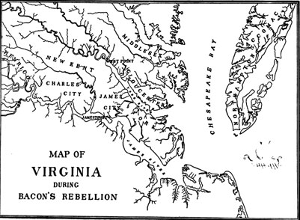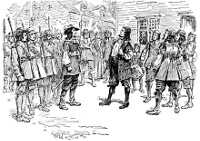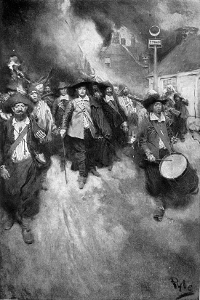Bacon's Rebellion
Bacon's Rebellion was a late 17th-Century insurrection against colonial rule in Virginia. It turned especially violent before things were ironed out. 
English settlers had first arrived to settle permanently in 1607, at Jamestown. As more English settlers arrived in the Virginia Colony and others along the Eastern Seaboard, more and more people set out westward, to explore and settle new lands. Invariably, these explorers and settlers came into conflict with Native Americans, who had been living on the continent for many generations. Many English settlers that they, not Native Americans, deserved the right to own and live on the land. Also at this time, the Virginia colony was suffering through economic problems. Tobacco prices had dropped, England had raised its prices on goods that Virginians (and other Americans) bought from England, and Virginia producers were encountering greater competition from neighboring colonies such as Maryland and North Carolina. As well, in the mid-1670s, the Virginia colony had suffered through a solid year of terrible weather, including floods, hailstorms, hurricanes, and even a bit of drought. Some colonists were looking for someone to blame. The colonists at first fixed blame on the Native Americans living in the area. Relations between the English colonists and the neighboring Native American tribes had been at times cordial and at other times hostile. Things began to worsen in July 1675. A farmer named Thomas Mathews had traded with members of the nearby Doeg tribe but had not paid them for the goods they provided him. Members of the Doeg tribe, in retaliation, stole a number of pigs from Mathews's farm. Things escalated severely then, as a number of settlers killed a number of Doeg, who responded by killing Robert Hen, who worked for Mathews. The local militia got involved at this point and responded by killing a number of Native Americans. However, those killed belonged not to the Doeg tribe but to the Susquehannock, a peaceful tribe who were not involved in the dispute. A number of Susquehannock responded violently, as did the militia. John Washington led a group of troops from Maryland and attacked the Susquehannock, killing many, including several of their leaders. 
At this point, Virginia Gov. William Berkeley attempted to keep the peace by ordering the construction of new forts and by instituting a law that allowed Native Americans to stay in colonial lands. Those actions enraged a number in the colony, including a man named Nathaniel Bacon, a plantation owner and member of Berkeley's council (and, in fact, a cousin of Berkeley). They formed a raiding party, armed themselves, and struck out against nearby Native Americans, initially by convincing one tribe, the Occaneechi, to attack another, the Susquehannock. Bacon and his raiding party then turned on the Occaneechi. Other targets of Bacon's men at this time were the Doeg tribe, who were involved with the beginning of escalations, and the Pamunkey tribe. The governor responded by calling for new elections to the colony's elected assembly, the House of Burgesses. The result was a quick election and then a quick set of new laws (which later became to be known as Bacon's Laws). The laws limited the governor's power and gave freemen who didn't have land the right to vote. On a more personal note, Berkeley also gathered a few hundred of his friends, armed them, and rode to where Bacon was living at the time. Bacon fled into the nearby forest. Berkeley branded Bacon a rebel and offered a pardon for any man who had taken up arms with Bacon but was willing to admit the wrong of that action and go home peacefully, without weapons. Bacon responded by attacking a nearby Native American camp. 
In the new elections called by Berkeley, Bacon had won a seat in the House of Burgesses. He attended an assembly called by Berkeley in June 1676. The governor pardoned Bacon and allowed him to join the assembly. In the midst of a heated argument about preferred actions toward neighboring Native American tribes, Bacon left in a huff. He came back with a few hundred men at his back. Bacon demanded a commission as compensation for leading another militia attack against Native Americans living nearby. Berkeley, refused, staring down Bacon and his 500 men and daring Bacon to shoot him. Bacon didn't take the bait, instead ordering his men to point their guns instead at the Burgesses. The commission was quickly granted. Bacon and his followers issued the Declaration of the People of Virginia on July 30, 1676. Among the elements of this document were accusations that Berkeley played favorites when handing out government offices and that he favored Native Americans' interests over those of Englishmen. Bacon gained more men as a result of this declaration, and the enmity between the two men grew. 
The conflict turned very violent, and Bacon and his men burned Jamestown to the ground on Sept. 19, 1676. Berkeley fled, seeking support from English troops stationed nearby. England dispatched a naval squadron to support Berkeley, and the prospect of sustained conflict grew. Bacon, by this time a magnetic figure and symbol of popular rebellion, died, on October 26, after contracting dysentery, an all-too-common enemy in colonial times. One of Bacon's followers, John Ingram, took the helm, but the rebellion largely collapsed without Bacon's leadership. Berkeley, with English troops behind him, struck back, and the rebellion collapsed. Berkeley was back in charge in Jamestown in January 1677. He took some measure of revenge, seizing the property of some of the primary members of the rebellion and executing nearly two dozen of them as well. He declared Bacon posthumously guilty of treason and seized his property. Berkeley didn't last long in power after that. A royal investigative committee reported to the English King, who at the time was Charles II, and the king recalled Berkeley to England. One significant development associated with Bacon's Rebellion was that both blacks and whites, indentured servants and slaves, joined the fight against the governor, fighting side by side. The rich and powerful in the Virginia colony and elsewhere saw this interracial competition as a cause for concern and shaped opinions that helped bring about some of the laws that protected or at least countenance slavery. It would not be the last slave rebellion in the U.S. |
|
Social Studies for Kids
copyright 2002–2025
David White




